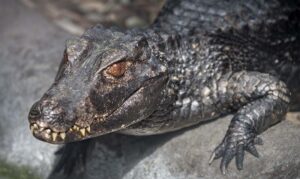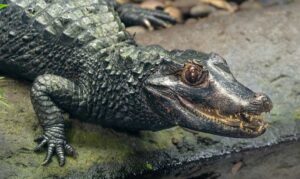About
The dwarf caiman is the smallest member of the alligator family. Hunting at night, these lizards drift along with only their eyes and nostrils above water, moving silently. When fish are within striking range, the caiman uses its tail and body to corral the fish and trap them in shallow water. Small fish, birds, and mammals are swallowed whole. Large prey is first drowned before the caiman rolls over to twist pieces of flesh from the carcass. Digestion is aided by stones that are swallowed (gastroliths) and remain in the stomach.
Dwarf caiman are strong swimmers with partially webbed hind feet and a strong tail that propels them through the water. Limbs are used for braking and steering. As protection from predators that include jaguars and anacondas, these reptiles have exceptionally tough skin and large scales reinforced with bony plates called osteoderms. Living alone or in pairs, dwarf caiman are secretive and mostly nocturnal. Special adaptations enhance these animals’ ability to see at night and allow limited underwater vision.


Habitat
Dwarf caiman are found in flooded rainforests and fast flowing rivers in Central and South America.
Diet
These carnivores eat a variety of fish, crustaceans, reptiles, bird, amphibians, snails, and insects.
Physical Characteristics
Dwarf caiman can reach five feet in length and weigh between 13 and 15 pounds. Lifespan in the wild is about 20 to 40 years, and in human care up to 60 years.


